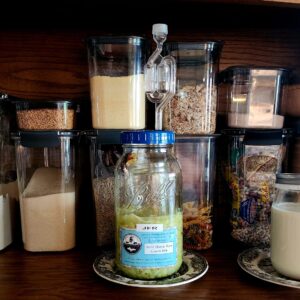
Traditional Sauerkraut
With good old-fashioned probiotics for your gut!
Equipment
- 1 Wide mouth mason jar w/ lid Quart size or larger
- 1 Large non-metal mixing bowl
- 1 Fermenting lid with airlock Optional- can use regular wide mouth lid in a pinch
- 1 Small Plate For under the jar
Ingredients
- 3 lb Cabbage, about 8" diameter Washed
- 1.5 tbsp kosher salt I used Celtic Sea Salt
- 1 tbsp Caraway Seeds- optional or to taste
- 2 tbsp Brine from a previous lacto-ferment kraut batch Optional to speed fermentation, not necessary.
Instructions
- Wash and dry all equipment and hands well!
- Remove the outer wilted leaves from the cabbage and discard. Quarter the head of cabbage and remove the stem and core. Save one large, inner leaf for later...
- Take each quarter and chop into thin ribbons and place the slices in a large bowl. Repeat with the rest of the cabbage. You can make your ribbons as thick or thin as you like.
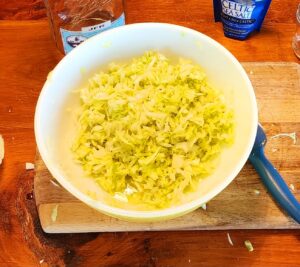
- Add the salt to the cabbage and knead with your hands for about 8-10 minutes, working the salt into the cabbage.
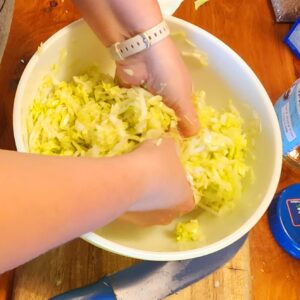
- When you're done, the cabbage will have reduced in bulk by about half and there should be some nice, briny liquid in the bottom of your bowl. If you are using the optional brine from another lacto-ferment, you can add it now.
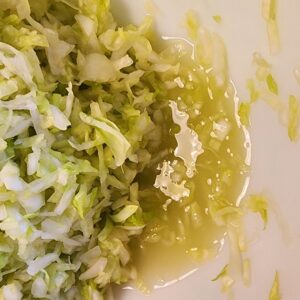
- At this point, if you are using them, you can add the caraway seeds and mix them in evenly. I love a traditional kraut, so I definitely do not skip this step!
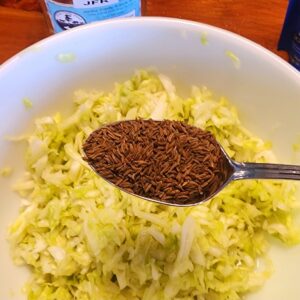
- Transfer cabbage and liquid from your mixing bowl to your wide mouth jar.
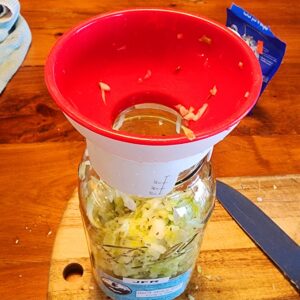
- Press the cabbage down into the jar with your fist as you go to squeeze the brine to the top. Once all the cabbage is in the jar, cut the reserved cabbage leaf to size and place it on top of the shredded cabbage, covering the top to keep it all under the brine. You can also add a weighted jelly jar to the jar, placed on top of the leaf, to keep everything down under the brine.

- Place your airlock lid on top tightly, add water to the airlock to the 'max' line (mine is marked) and place it in on a plate at room temperature. If you don't have an airlock lid, you can use a regular wide mouth jar lid on loosely so that the jar can vent as the cabbage ferments. I always put a plate underneath my fermenting jars just in case it gets bumped or bubbles over.
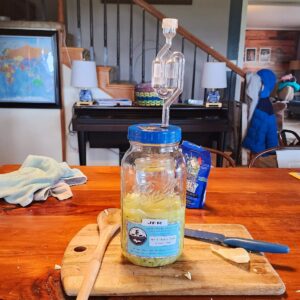
- Press the cabbage down every day to keep it under the liquid brine. If you don't get enough brine to cover the cabbage, you can dissolve 1 tsp salt in 1 cup of water and add this to your jar. It's important that the cabbage stays completely covered. (this picture is from 24 hrs later)
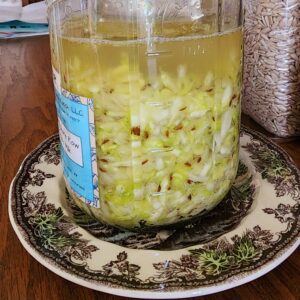
- If you see white scum or mold floating on top, it should be skimmed off and discarded. There can also be mold that forms on the top of the kraut at the end of fermentation, just discard that layer and what is below is fine!
- You can check the taste and texture after a few days, and let it ferment until you are happy with both. I like my cabbage to still have a little body to it, other folks might like it more mushy. Once you are happy with it, you can move the jar (with a tight regular lid) to the fridge and it will stay fresh for a few months, but I doubt it will last that long!